Drug-Resistant Tuberculosis: Social Epidemiology Analysis and Report
VerifiedAdded on 2022/09/18
|8
|1867
|25
Report
AI Summary
This report provides a comprehensive overview of the social epidemiology of Multi-Drug Resistant Tuberculosis (MDR-TB). It begins with an introduction to social epidemiology and its relevance to health outcomes. The report then delves into MDR-TB, defining the disease, its drug resistance mechanisms, and the challenges in treatment. A significant portion focuses on understanding the social determinants of TB, including crowded environments, poor working conditions, undernutrition, and lack of health knowledge. The report also examines the global estimates of MDR-TB cases, citing statistics from various surveys. A literature review synthesizes key findings from several research articles, highlighting factors contributing to the high prevalence of MDR-TB, social behavior risk factors, and the impact of social inequalities. The report concludes by emphasizing the crucial role of social policies and medical interventions in controlling the spread of this life-threatening disease.
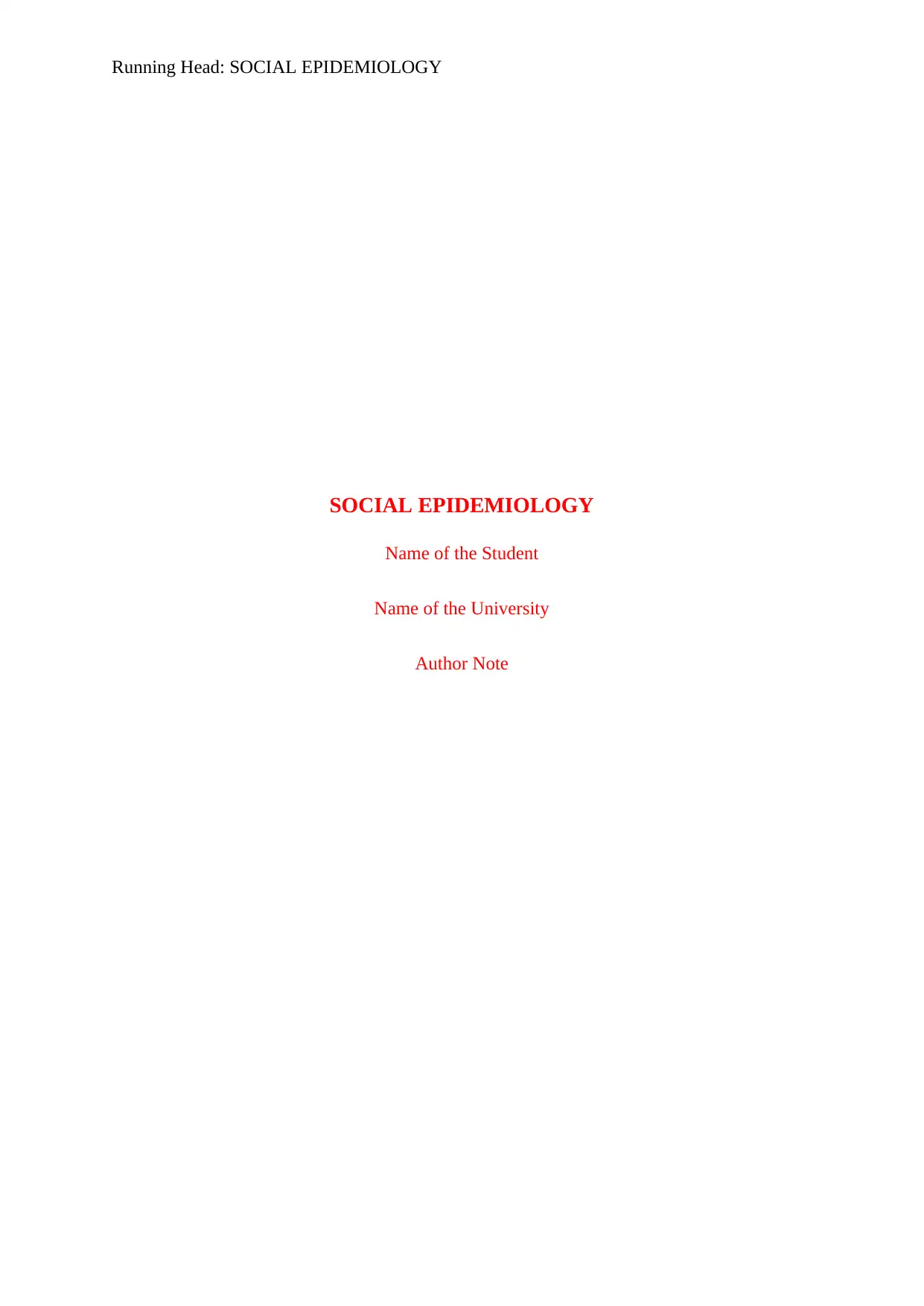
Running Head: SOCIAL EPIDEMIOLOGY
SOCIAL EPIDEMIOLOGY
Name of the Student
Name of the University
Author Note
SOCIAL EPIDEMIOLOGY
Name of the Student
Name of the University
Author Note
Paraphrase This Document
Need a fresh take? Get an instant paraphrase of this document with our AI Paraphraser

1SOCIAL EPIDEMIOLOGY
INTRODUCTION
Social Epidemiology is a branch of Epidemiology, focused on the effects that socio
structural factors tend to have on the various states of health. It takes into consideration the
various advantages and disadvantages within a society that mirrors how heath and disease
may be distributed. It is focused on social characteristics that point at and affect the patterns
related with health and disease (berkman, Kawachi & Glymour, 2014). This assignment is a
study on Drug Resistant Tuberculosis, which is causing a lot of damage to various parts of
the world. The social Epidemiological factors will be studied by reviewing Literature related
to the same.
MULTI DRUG RESISTANT TUBERCULOSIS
Multi Drug Resistant Tuberculosis or MDR-TB is a kind of Tuberculosis that is an
infection caused by a bacteria that is resistant to all kinds of treatment. They are resistant
even to the powerful Tb medications that include Isoniazid and Rifampin. It is also resistant
to Fluoroquinolone. The treatment for this kind of TB tends to extend for about two years
while in actuality Tb tends to treated within Six Months (Ormerod, 2005). This has various
patterns in society is a problematic issues in various countries, especially China, because the
people affected by this tend to be resistant to the drugs.
UNDERSTANDING THE TREATMENT
Understanding the treatment of normal tuberculosis is important to understand the
origin of MDR-TB. To cure MDR-Tb the second line of drugs are used as the first line fails
to work, these drugs are far more expensive than the first line and they have more adverse
effects than the first line of drugs. The people who are afflicted to MDR-TB show resistance
to the isoniazid and rifampin. When TB was being treated, these organisms had attained a
INTRODUCTION
Social Epidemiology is a branch of Epidemiology, focused on the effects that socio
structural factors tend to have on the various states of health. It takes into consideration the
various advantages and disadvantages within a society that mirrors how heath and disease
may be distributed. It is focused on social characteristics that point at and affect the patterns
related with health and disease (berkman, Kawachi & Glymour, 2014). This assignment is a
study on Drug Resistant Tuberculosis, which is causing a lot of damage to various parts of
the world. The social Epidemiological factors will be studied by reviewing Literature related
to the same.
MULTI DRUG RESISTANT TUBERCULOSIS
Multi Drug Resistant Tuberculosis or MDR-TB is a kind of Tuberculosis that is an
infection caused by a bacteria that is resistant to all kinds of treatment. They are resistant
even to the powerful Tb medications that include Isoniazid and Rifampin. It is also resistant
to Fluoroquinolone. The treatment for this kind of TB tends to extend for about two years
while in actuality Tb tends to treated within Six Months (Ormerod, 2005). This has various
patterns in society is a problematic issues in various countries, especially China, because the
people affected by this tend to be resistant to the drugs.
UNDERSTANDING THE TREATMENT
Understanding the treatment of normal tuberculosis is important to understand the
origin of MDR-TB. To cure MDR-Tb the second line of drugs are used as the first line fails
to work, these drugs are far more expensive than the first line and they have more adverse
effects than the first line of drugs. The people who are afflicted to MDR-TB show resistance
to the isoniazid and rifampin. When TB was being treated, these organisms had attained a
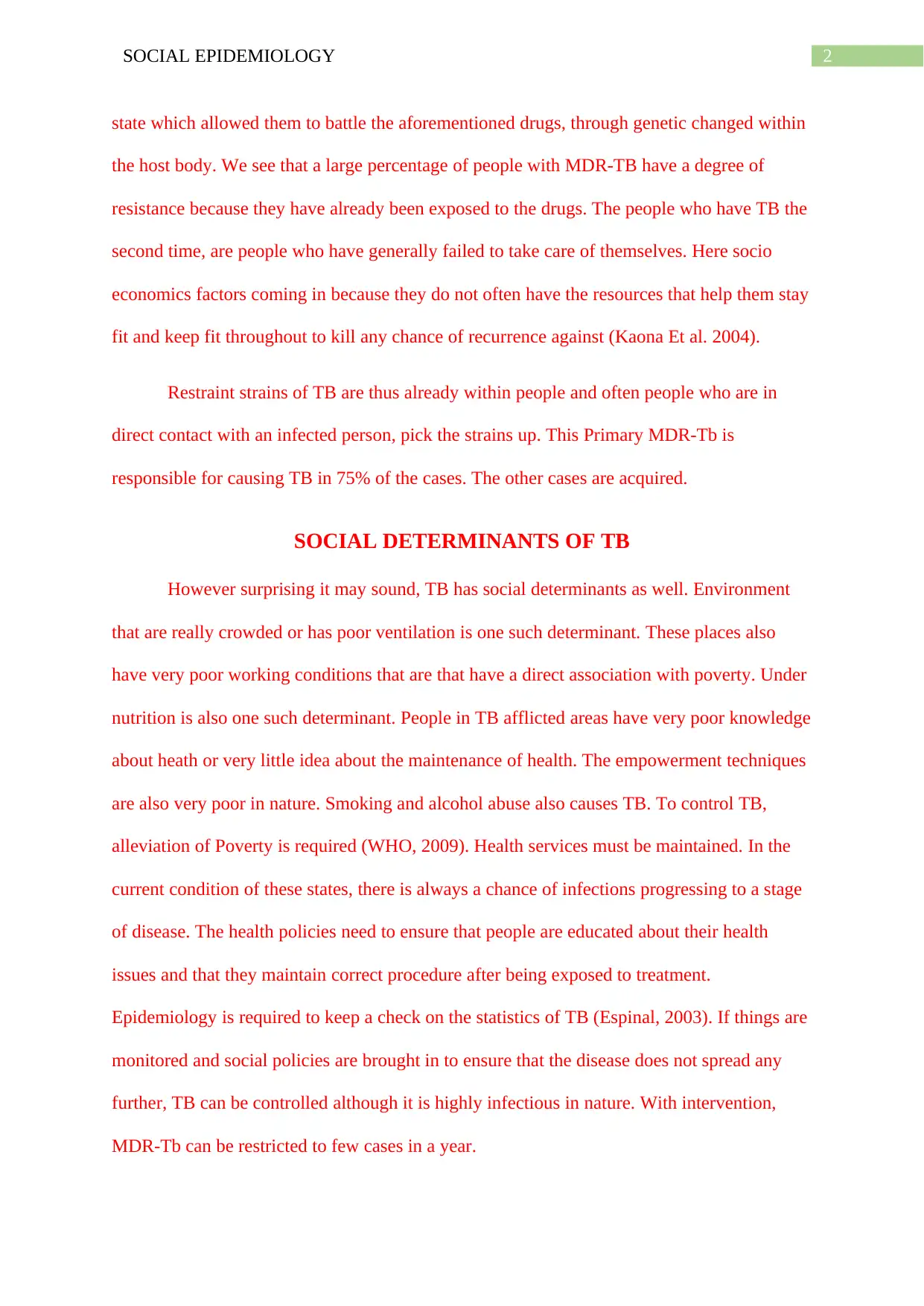
2SOCIAL EPIDEMIOLOGY
state which allowed them to battle the aforementioned drugs, through genetic changed within
the host body. We see that a large percentage of people with MDR-TB have a degree of
resistance because they have already been exposed to the drugs. The people who have TB the
second time, are people who have generally failed to take care of themselves. Here socio
economics factors coming in because they do not often have the resources that help them stay
fit and keep fit throughout to kill any chance of recurrence against (Kaona Et al. 2004).
Restraint strains of TB are thus already within people and often people who are in
direct contact with an infected person, pick the strains up. This Primary MDR-Tb is
responsible for causing TB in 75% of the cases. The other cases are acquired.
SOCIAL DETERMINANTS OF TB
However surprising it may sound, TB has social determinants as well. Environment
that are really crowded or has poor ventilation is one such determinant. These places also
have very poor working conditions that are that have a direct association with poverty. Under
nutrition is also one such determinant. People in TB afflicted areas have very poor knowledge
about heath or very little idea about the maintenance of health. The empowerment techniques
are also very poor in nature. Smoking and alcohol abuse also causes TB. To control TB,
alleviation of Poverty is required (WHO, 2009). Health services must be maintained. In the
current condition of these states, there is always a chance of infections progressing to a stage
of disease. The health policies need to ensure that people are educated about their health
issues and that they maintain correct procedure after being exposed to treatment.
Epidemiology is required to keep a check on the statistics of TB (Espinal, 2003). If things are
monitored and social policies are brought in to ensure that the disease does not spread any
further, TB can be controlled although it is highly infectious in nature. With intervention,
MDR-Tb can be restricted to few cases in a year.
state which allowed them to battle the aforementioned drugs, through genetic changed within
the host body. We see that a large percentage of people with MDR-TB have a degree of
resistance because they have already been exposed to the drugs. The people who have TB the
second time, are people who have generally failed to take care of themselves. Here socio
economics factors coming in because they do not often have the resources that help them stay
fit and keep fit throughout to kill any chance of recurrence against (Kaona Et al. 2004).
Restraint strains of TB are thus already within people and often people who are in
direct contact with an infected person, pick the strains up. This Primary MDR-Tb is
responsible for causing TB in 75% of the cases. The other cases are acquired.
SOCIAL DETERMINANTS OF TB
However surprising it may sound, TB has social determinants as well. Environment
that are really crowded or has poor ventilation is one such determinant. These places also
have very poor working conditions that are that have a direct association with poverty. Under
nutrition is also one such determinant. People in TB afflicted areas have very poor knowledge
about heath or very little idea about the maintenance of health. The empowerment techniques
are also very poor in nature. Smoking and alcohol abuse also causes TB. To control TB,
alleviation of Poverty is required (WHO, 2009). Health services must be maintained. In the
current condition of these states, there is always a chance of infections progressing to a stage
of disease. The health policies need to ensure that people are educated about their health
issues and that they maintain correct procedure after being exposed to treatment.
Epidemiology is required to keep a check on the statistics of TB (Espinal, 2003). If things are
monitored and social policies are brought in to ensure that the disease does not spread any
further, TB can be controlled although it is highly infectious in nature. With intervention,
MDR-Tb can be restricted to few cases in a year.
⊘ This is a preview!⊘
Do you want full access?
Subscribe today to unlock all pages.

Trusted by 1+ million students worldwide
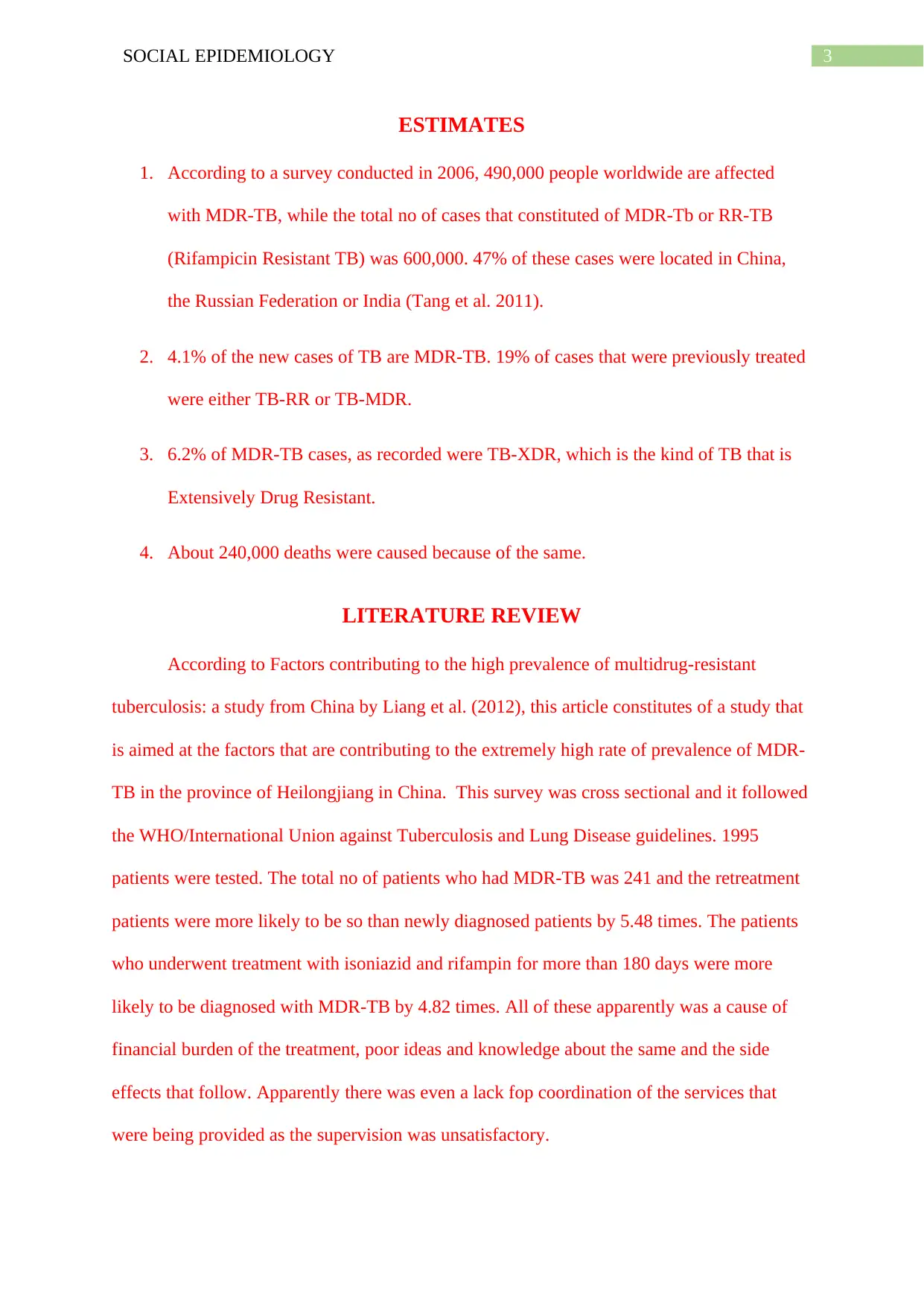
3SOCIAL EPIDEMIOLOGY
ESTIMATES
1. According to a survey conducted in 2006, 490,000 people worldwide are affected
with MDR-TB, while the total no of cases that constituted of MDR-Tb or RR-TB
(Rifampicin Resistant TB) was 600,000. 47% of these cases were located in China,
the Russian Federation or India (Tang et al. 2011).
2. 4.1% of the new cases of TB are MDR-TB. 19% of cases that were previously treated
were either TB-RR or TB-MDR.
3. 6.2% of MDR-TB cases, as recorded were TB-XDR, which is the kind of TB that is
Extensively Drug Resistant.
4. About 240,000 deaths were caused because of the same.
LITERATURE REVIEW
According to Factors contributing to the high prevalence of multidrug-resistant
tuberculosis: a study from China by Liang et al. (2012), this article constitutes of a study that
is aimed at the factors that are contributing to the extremely high rate of prevalence of MDR-
TB in the province of Heilongjiang in China. This survey was cross sectional and it followed
the WHO/International Union against Tuberculosis and Lung Disease guidelines. 1995
patients were tested. The total no of patients who had MDR-TB was 241 and the retreatment
patients were more likely to be so than newly diagnosed patients by 5.48 times. The patients
who underwent treatment with isoniazid and rifampin for more than 180 days were more
likely to be diagnosed with MDR-TB by 4.82 times. All of these apparently was a cause of
financial burden of the treatment, poor ideas and knowledge about the same and the side
effects that follow. Apparently there was even a lack fop coordination of the services that
were being provided as the supervision was unsatisfactory.
ESTIMATES
1. According to a survey conducted in 2006, 490,000 people worldwide are affected
with MDR-TB, while the total no of cases that constituted of MDR-Tb or RR-TB
(Rifampicin Resistant TB) was 600,000. 47% of these cases were located in China,
the Russian Federation or India (Tang et al. 2011).
2. 4.1% of the new cases of TB are MDR-TB. 19% of cases that were previously treated
were either TB-RR or TB-MDR.
3. 6.2% of MDR-TB cases, as recorded were TB-XDR, which is the kind of TB that is
Extensively Drug Resistant.
4. About 240,000 deaths were caused because of the same.
LITERATURE REVIEW
According to Factors contributing to the high prevalence of multidrug-resistant
tuberculosis: a study from China by Liang et al. (2012), this article constitutes of a study that
is aimed at the factors that are contributing to the extremely high rate of prevalence of MDR-
TB in the province of Heilongjiang in China. This survey was cross sectional and it followed
the WHO/International Union against Tuberculosis and Lung Disease guidelines. 1995
patients were tested. The total no of patients who had MDR-TB was 241 and the retreatment
patients were more likely to be so than newly diagnosed patients by 5.48 times. The patients
who underwent treatment with isoniazid and rifampin for more than 180 days were more
likely to be diagnosed with MDR-TB by 4.82 times. All of these apparently was a cause of
financial burden of the treatment, poor ideas and knowledge about the same and the side
effects that follow. Apparently there was even a lack fop coordination of the services that
were being provided as the supervision was unsatisfactory.
Paraphrase This Document
Need a fresh take? Get an instant paraphrase of this document with our AI Paraphraser
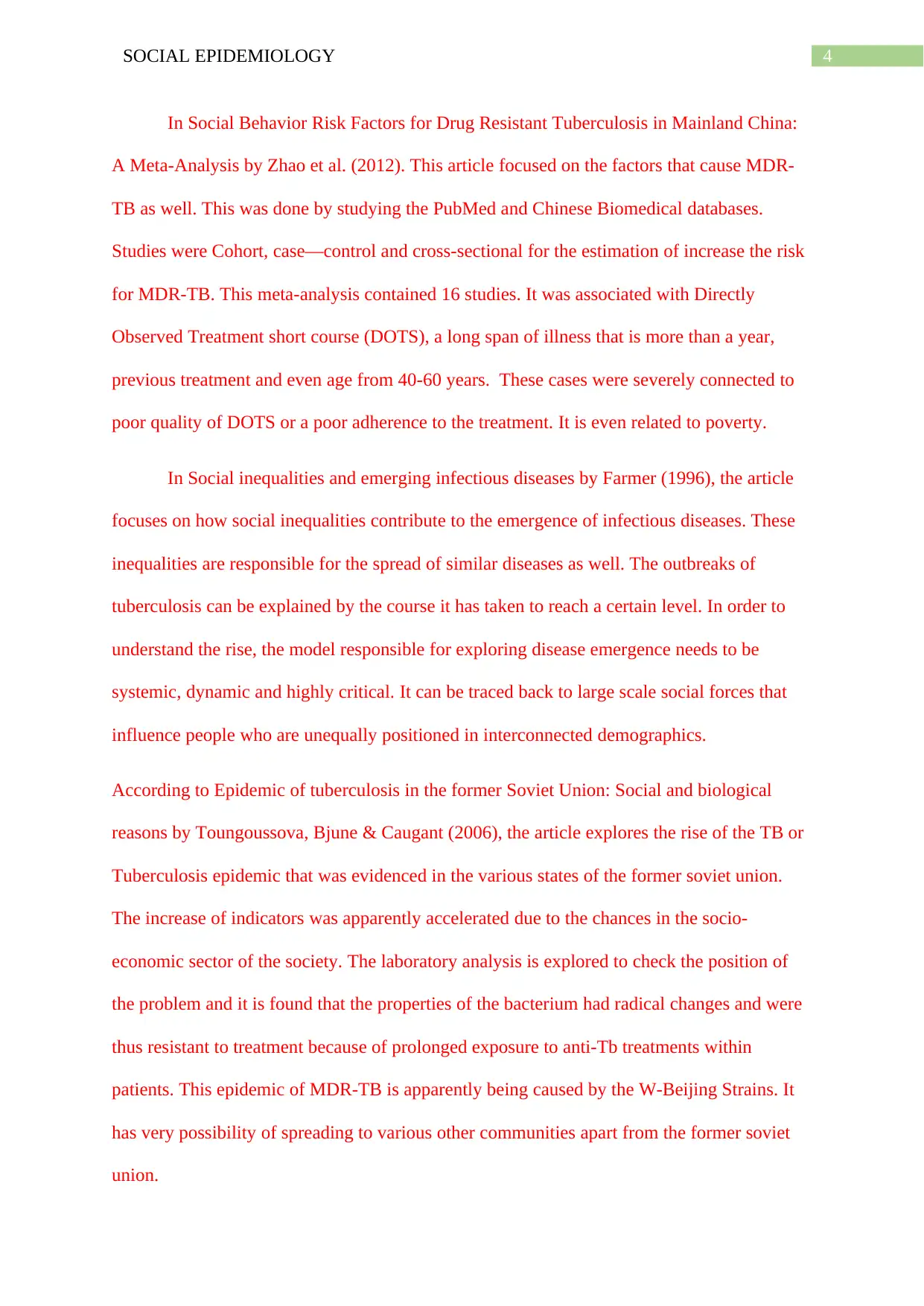
4SOCIAL EPIDEMIOLOGY
In Social Behavior Risk Factors for Drug Resistant Tuberculosis in Mainland China:
A Meta-Analysis by Zhao et al. (2012). This article focused on the factors that cause MDR-
TB as well. This was done by studying the PubMed and Chinese Biomedical databases.
Studies were Cohort, case—control and cross-sectional for the estimation of increase the risk
for MDR-TB. This meta-analysis contained 16 studies. It was associated with Directly
Observed Treatment short course (DOTS), a long span of illness that is more than a year,
previous treatment and even age from 40-60 years. These cases were severely connected to
poor quality of DOTS or a poor adherence to the treatment. It is even related to poverty.
In Social inequalities and emerging infectious diseases by Farmer (1996), the article
focuses on how social inequalities contribute to the emergence of infectious diseases. These
inequalities are responsible for the spread of similar diseases as well. The outbreaks of
tuberculosis can be explained by the course it has taken to reach a certain level. In order to
understand the rise, the model responsible for exploring disease emergence needs to be
systemic, dynamic and highly critical. It can be traced back to large scale social forces that
influence people who are unequally positioned in interconnected demographics.
According to Epidemic of tuberculosis in the former Soviet Union: Social and biological
reasons by Toungoussova, Bjune & Caugant (2006), the article explores the rise of the TB or
Tuberculosis epidemic that was evidenced in the various states of the former soviet union.
The increase of indicators was apparently accelerated due to the chances in the socio-
economic sector of the society. The laboratory analysis is explored to check the position of
the problem and it is found that the properties of the bacterium had radical changes and were
thus resistant to treatment because of prolonged exposure to anti-Tb treatments within
patients. This epidemic of MDR-TB is apparently being caused by the W-Beijing Strains. It
has very possibility of spreading to various other communities apart from the former soviet
union.
In Social Behavior Risk Factors for Drug Resistant Tuberculosis in Mainland China:
A Meta-Analysis by Zhao et al. (2012). This article focused on the factors that cause MDR-
TB as well. This was done by studying the PubMed and Chinese Biomedical databases.
Studies were Cohort, case—control and cross-sectional for the estimation of increase the risk
for MDR-TB. This meta-analysis contained 16 studies. It was associated with Directly
Observed Treatment short course (DOTS), a long span of illness that is more than a year,
previous treatment and even age from 40-60 years. These cases were severely connected to
poor quality of DOTS or a poor adherence to the treatment. It is even related to poverty.
In Social inequalities and emerging infectious diseases by Farmer (1996), the article
focuses on how social inequalities contribute to the emergence of infectious diseases. These
inequalities are responsible for the spread of similar diseases as well. The outbreaks of
tuberculosis can be explained by the course it has taken to reach a certain level. In order to
understand the rise, the model responsible for exploring disease emergence needs to be
systemic, dynamic and highly critical. It can be traced back to large scale social forces that
influence people who are unequally positioned in interconnected demographics.
According to Epidemic of tuberculosis in the former Soviet Union: Social and biological
reasons by Toungoussova, Bjune & Caugant (2006), the article explores the rise of the TB or
Tuberculosis epidemic that was evidenced in the various states of the former soviet union.
The increase of indicators was apparently accelerated due to the chances in the socio-
economic sector of the society. The laboratory analysis is explored to check the position of
the problem and it is found that the properties of the bacterium had radical changes and were
thus resistant to treatment because of prolonged exposure to anti-Tb treatments within
patients. This epidemic of MDR-TB is apparently being caused by the W-Beijing Strains. It
has very possibility of spreading to various other communities apart from the former soviet
union.

5SOCIAL EPIDEMIOLOGY
CONCLUSION
In conclusion, it is evident that MDR-TB is highly present in places that have a high
density of population and the places that have poor living conditions, coupled with poverty.
Social factors thus have an enormous impact on this disease, and thus social policies along
with medical science, can be implemented to ensure that this life taking disease is brought
under control.
CONCLUSION
In conclusion, it is evident that MDR-TB is highly present in places that have a high
density of population and the places that have poor living conditions, coupled with poverty.
Social factors thus have an enormous impact on this disease, and thus social policies along
with medical science, can be implemented to ensure that this life taking disease is brought
under control.
⊘ This is a preview!⊘
Do you want full access?
Subscribe today to unlock all pages.

Trusted by 1+ million students worldwide

6SOCIAL EPIDEMIOLOGY
References
Berkman, L. F., Kawachi, I., & Glymour, M. M. (Eds.). (2014). Social epidemiology. Oxford
University Press.
Espinal, M. A. (2003). The global situation of MDR-TB. Tuberculosis, 83(1-3), 44-51.
Farmer, P. (1996). Social inequalities and emerging infectious diseases. Emerging infectious
diseases, 2(4), 259.
Kaona, F. A., Tuba, M., Siziya, S., & Sikaona, L. (2004). An assessment of factors
contributing to treatment adherence and knowledge of TB transmission among
patients on TB treatment. BMC Public health, 4(1), 68.
Liang, L., Wu, Q., Gao, L., Hao, Y., Liu, C., Xie, Y., ... & Fang, H. (2012). Factors
contributing to the high prevalence of multidrug-resistant tuberculosis: a study from
China. Thorax, 67(7), 632-638.
Ormerod, L. P. (2005). Multidrug-resistant tuberculosis (MDR-TB): epidemiology,
prevention and treatment. British medical bulletin, 73(1), 17-24.
Tang, S., Zhang, Q., Yu, J., Liu, Y., Sha, W., Sun, H., ... & Xiao, H. (2011). Extensively
drug-resistant tuberculosis, China. Emerging infectious diseases, 17(3), 558.
Toungoussova, O. S., Bjune, G., & Caugant, D. A. (2006). Epidemic of tuberculosis in the
former Soviet Union: social and biological reasons. Tuberculosis, 86(1), 1-10.
World Health Organization. (2009). WHO policy on TB infection control in health-care
facilities, congregate settings and households (No. WHO/HTM/TB/2009.419).
Geneva: World Health Organization.
References
Berkman, L. F., Kawachi, I., & Glymour, M. M. (Eds.). (2014). Social epidemiology. Oxford
University Press.
Espinal, M. A. (2003). The global situation of MDR-TB. Tuberculosis, 83(1-3), 44-51.
Farmer, P. (1996). Social inequalities and emerging infectious diseases. Emerging infectious
diseases, 2(4), 259.
Kaona, F. A., Tuba, M., Siziya, S., & Sikaona, L. (2004). An assessment of factors
contributing to treatment adherence and knowledge of TB transmission among
patients on TB treatment. BMC Public health, 4(1), 68.
Liang, L., Wu, Q., Gao, L., Hao, Y., Liu, C., Xie, Y., ... & Fang, H. (2012). Factors
contributing to the high prevalence of multidrug-resistant tuberculosis: a study from
China. Thorax, 67(7), 632-638.
Ormerod, L. P. (2005). Multidrug-resistant tuberculosis (MDR-TB): epidemiology,
prevention and treatment. British medical bulletin, 73(1), 17-24.
Tang, S., Zhang, Q., Yu, J., Liu, Y., Sha, W., Sun, H., ... & Xiao, H. (2011). Extensively
drug-resistant tuberculosis, China. Emerging infectious diseases, 17(3), 558.
Toungoussova, O. S., Bjune, G., & Caugant, D. A. (2006). Epidemic of tuberculosis in the
former Soviet Union: social and biological reasons. Tuberculosis, 86(1), 1-10.
World Health Organization. (2009). WHO policy on TB infection control in health-care
facilities, congregate settings and households (No. WHO/HTM/TB/2009.419).
Geneva: World Health Organization.
Paraphrase This Document
Need a fresh take? Get an instant paraphrase of this document with our AI Paraphraser
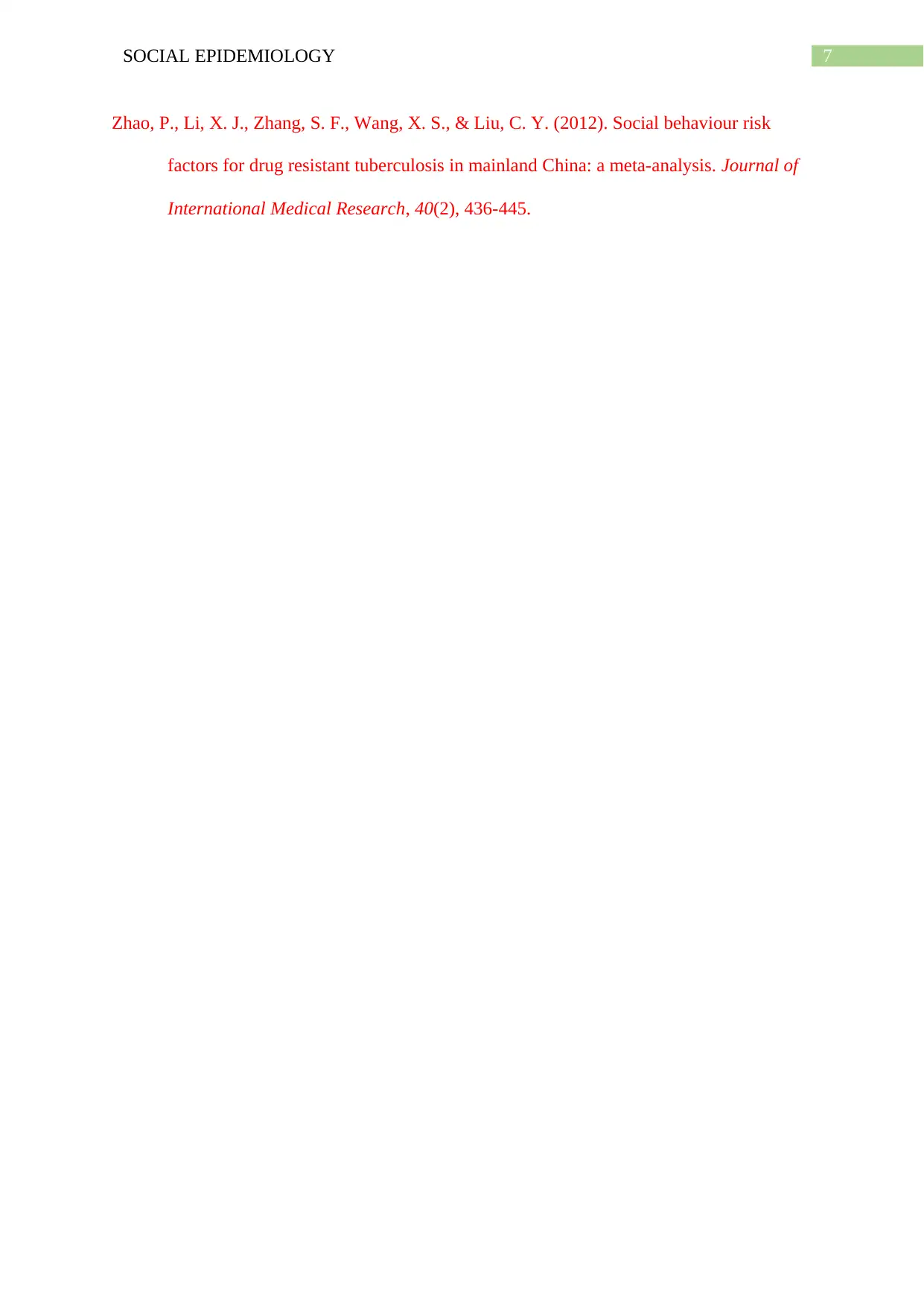
7SOCIAL EPIDEMIOLOGY
Zhao, P., Li, X. J., Zhang, S. F., Wang, X. S., & Liu, C. Y. (2012). Social behaviour risk
factors for drug resistant tuberculosis in mainland China: a meta-analysis. Journal of
International Medical Research, 40(2), 436-445.
Zhao, P., Li, X. J., Zhang, S. F., Wang, X. S., & Liu, C. Y. (2012). Social behaviour risk
factors for drug resistant tuberculosis in mainland China: a meta-analysis. Journal of
International Medical Research, 40(2), 436-445.
1 out of 8
Related Documents
Your All-in-One AI-Powered Toolkit for Academic Success.
+13062052269
info@desklib.com
Available 24*7 on WhatsApp / Email
![[object Object]](/_next/static/media/star-bottom.7253800d.svg)
Unlock your academic potential
Copyright © 2020–2025 A2Z Services. All Rights Reserved. Developed and managed by ZUCOL.





